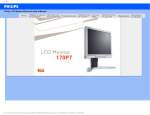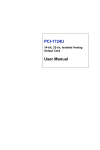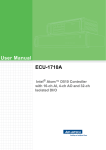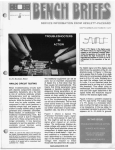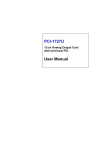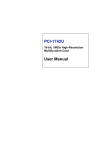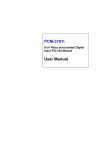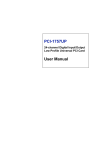Download Advantech PCI-1720U User manual
Transcript
PCI-1720
4-ch Isolated Analog Output
Card
PCI-1720U
4-ch Isolated Analog Output
Card with Universal PCI Bus
User Manual
Copyright
This documentation and the software included with this product are
copyrighted 2005 by Advantech Co., Ltd. All rights are reserved.
Advantech Co., Ltd. reserves the right to make improvements in the
products described in this manual at any time without notice.
No part of this manual may be reproduced, copied, translated or
transmitted in any form or by any means without the prior written
permission of Advantech Co., Ltd. Information provided in this manual is
intended to be accurate and reliable. However, Advantech Co., Ltd.
assumes no responsibility for its use, nor for any infringements of the
rights of third parties which may result from its use.
Acknowledgments
PC-LabCard is a trademark of Advantech Co., Ltd. IBM and PC are
trademarks of International Business Machines Corporation. MS-DOS
and Windows are trademarks of Microsoft Corporation. Intel and Pentium
are trademarks of Intel Corporation. All other product names or trademarks are properties of their respective owners.
Part No. 2003172011
2nd Edition
Printed in Taiwan
May 2005
PCI-1720 & 1720U User Manual
ii
Product Warranty (2 years)
Advantech warrants to you, the original purchaser, that each of its products will be free from defects in materials and workmanship for two years
from the date of purchase.
This warranty does not apply to any products which have been repaired or
altered by persons other than repair personnel authorized by Advantech,
or which have been subject to misuse, abuse, accident or improper installation. Advantech assumes no liability under the terms of this warranty as
a consequence of such events.
Because of Advantech’s high quality-control standards and rigorous testing, most of our customers never need to use our repair service. If an
Advantech product is defective, it will be repaired or replaced at no
charge during the warranty period. For out-of-warranty repairs, you will
be billed according to the cost of replacement materials, service time and
freight. Please consult your dealer for more details.
If you think you have a defective product, follow these steps:
1.
Collect all the information about the problem encountered. (For
example, CPU speed, Advantech products used, other hardware
and software used, etc.) Note anything abnormal and list any
onscreen messages you get when the problem occurs.
2.
Call your dealer and describe the problem. Please have your manual, product, and any helpful information readily available.
3.
If your product is diagnosed as defective, obtain an RMA (return
merchandize authorization) number from your dealer. This allows
us to process your return more quickly.
4.
Carefully pack the defective product, a fully-completed Repair and
Replacement Order Card and a photocopy proof of purchase date
(such as your sales receipt) in a shippable container. A product
returned without proof of the purchase date is not eligible for warranty service.
5.
Write the RMA number visibly on the outside of the package and
ship it prepaid to your dealer.
iii
CE Notification
PCI-1720 and PCI-1720U have passed the CE test for environmental
specifications when shielded cables are used for external wiring. We recommend the use of shielded cables. This kind of cable is available from
Advantech. Please contact your local supplier for ordering information.
Technical Support and Assistance
Step 1. Visit the Advantech web site at www.advantech.com/support
where you can find the latest information about the product.
Step 2. Contact your distributor, sales representative, or Advantech's customer service center for technical support if you need additional
assistance. Please have the following information ready before
you call:
- Product name and serial number
- Description of your peripheral attachments
- Description of your software (operating system, version, application software, etc.)
- A complete description of the problem
- The exact wording of any error messages
Safety Precaution - Static Electricity
Follow these simple precautions to protect yourself from harm and the
products from damage.
1.
To avoid electrical shock, always disconnect the power from your
PC chassis before you work on it. Don't touch any components on
the CPU card or other cards while the PC is on.
2.
Disconnect power before making any configuration changes. The
sudden rush of power as you connect a jumper or install a card may
damage sensitive electronic components.
Packing List
Before setting up the system, check that the items listed below are
included and in good condition. If any item does not accord with the
table, please contact your dealer immediately.
1x PCI-1720 or PCI-1720Ucard
1x Companion CD-ROM (DLL driver included)
1x User Manual (this manual)
PCI-1720 & 1720U User Manual
iv
Contents
Chapter
1.1
1.2
1.3
1.4
1.5
Chapter
1 General Information ....................................... 2
Introduction .................................................................................
Features........................................................................................
Applications.................................................................................
Specifications...............................................................................
Block Diagram.............................................................................
2
2
3
3
4
2 Installation ....................................................... 6
2.1 Unpacking.................................................................................... 6
2.2 Driver Installation........................................................................ 7
Figure 2.1: Setup Screen of Advantech Automation Software 7
Figure 2.2: Different Options for Driver Setup ........................ 8
2.3 Hardware Installation .................................................................. 9
Figure 2.3: The Device Name Listed on Device Manager .... 10
2.4 Device Setup and Configuration ............................................... 11
2.4.1 Setting Up the Device ............................................................. 11
Figure 2.4: The Device Manager Dialog Box ........................ 11
2.4.2 Configuring the Device .......................................................... 12
Figure 2.5: The Device Setting dialog box ............................ 12
Figure 2.6: Device Name Appearing on List of Devices Box 13
Chapter
3 Jumpers and I/O Connectors ....................... 16
Figure 3.1: Jumper Locations (SW1 is only for PCI-1720U) 16
3.1 Jumper Settings.......................................................................... 16
3.1.1 Using Jumpers to Set Current Sink Ranges ............................ 16
Figure 3.2: Jumper Settings for PCI-1720U’s Current Sink
Range ................................................................... 16
3.1.2 Jumper JP5 Setting for the Reset State ................................... 17
Figure 3.3: Jumper JP5 Setting for the Reset State ................ 17
3.2 Connector and Pin Assignments................................................ 18
Figure 3.4: PCI-1720U Pin Assignments ............................... 18
3.2.1 Signal Descriptions of I/O Connector .................................... 19
3.3 Setting the BoardID Switch (SW1) ........................................... 20
Table 3.1: Board ID Setting (SW1) ...................................... 20
3.3.1 Identity Register ..................................................................... 21
v
Table of Contents
Table 3.2: Identity Register of PCI-1720U ........................... 21
Chapter
4 Register Structure and Format.................... 24
4.1 Overview ................................................................................... 24
4.2 I/O Port Address Map................................................................ 25
Table 4.1: Register Format and Function Description .......... 25
4.2.1 D/A Output Channel 0 to 3 ..................................................... 26
Table 4.2: Register for D/A Data .......................................... 26
4.2.2 D/A Voltage Range and Polarity ............................................ 26
Table 4.3: Register for D/A Voltage Range and Polarity ..... 26
Table 4.4: Output Range of D/A Channel n ......................... 26
4.2.3 Synchronized Output Prompt Register ................................... 27
4.2.4 Synchronized Output Control Bitt .......................................... 27
Table 4.5: Synchronized Output Control Bit ........................ 27
4.3 Unipolar and Bipolar Binary Code Tables ................................ 28
Table 4.6: Unipolar Binary Code Table ............................... 28
Table 4.7: Bipolar Binary Code Table .................................. 28
Chapter
5 Signal Connections ........................................ 30
5.1 Overview ................................................................................... 30
5.2 D/A Voltage Output Connections.............................................. 30
Figure 5.1: Floating-load Conn. for D/A Voltage Output ...... 30
Figure 5.2: Grounded-load Conn. for D/A Voltage Output ... 31
Figure 5.3: Differential-load Conn. for D/A Voltage Output 31
5.3 Current Sink Connections.......................................................... 32
Figure 5.4: Grounded-load connection with a floating power
supply .................................................................. 32
Figure 5.5: Floating-load connection with a grounded power
supply .................................................................. 32
Figure 5.6: Floating-load Conn. with an Internal +12 VDC Power Supply .............................................................. 33
5.4 Current Sink Load and Power Supply ....................................... 33
Figure 5.7: PCI-1720U Current Sink Circuitry ...................... 33
Appendix A Calibration ..................................................... 36
A.1 Overview ................................................................................... 36
A.2 Starting Calibration.................................................................... 37
Figure A.1: PCI-1720U VR assignment ................................. 37
A.3 Unipolar Output Calibration...................................................... 38
A.4 Bipolar Output Calibration ........................................................ 38
A.5 Current Sink Calibration............................................................ 38
PCI-1720 & 1720U User Manual
vi
1
CHAPTER
2
General Information
Chapter 1 General Information
1.1 Introduction
PCI-1720 cards are isolated analog output cards. They provide four 12-bit
analog output channels with isolation protection of 2,500 V DC between
the outputs and the PCI bus. This is ideal for industrial applications
where high-voltage protection is required. PCI-1720U is also equipped
with a universal PCI interface.
Keeping the Output Settings and Values after System Reset
The four outputs can be set independently to different ranges:
0 to +5 V, 0 to +10 V, ±5 V, ±10 V, 0 to 20 mA (sink) or 4 to 20 mA
(sink). When the system is hot reset (the power is not shut off),
PCI-1720 cards can either retain the last analog output settings and values, or return to its default configuration based on its jumper setting. This
practical function eliminates danger caused by misoperation during
unexpected system resets.
PCI-bus Plug & Play
The PCI-1720 cards use a PCI controller to interface the cards to the PCI
bus. The controller fully implements the PCI bus specification Rev 2.1.
All bus relative configurations, such as base address and interrupt assignment, are automatically controlled by software.
1.2 Features
• Four 12-bit D/A output channels
• Multiple output ranges
• 2500 VDC isolation between the outputs and the PCI bus
• Keeps the output settings and values after system reset
• One 37-pin D-type connector for easy wiring
• BoardID switch
• Universal PCI Bus (PCI-1720U only)
• Glitch-free power up
PCI-1720 & 1720U User Manual
2
1.3 Applications
• Process control
• Programmable voltage source
• Programmable current sink
• Servo control
1.4 Specifications
D/A Output
• Channels: 4 isolated D/A channels
• Resolution: 12 bits
• Output Ranges:Unipolar: 0 ~ +5 V, 0 ~ +10 V
Bipolar: ±5 V, ±10 V
Current loop (sink): 0 ~ 20 mA, 4 ~ 20 mA
• Throughput: 500 kHz
• Accuracy: ±0.024%
• Isolation Voltage: 2,500 V DC between the outputs and the PCI bus
• Output Current: ±5 mA max.
• Current Loop Excitation Voltage: 50 V max.
• On-board 12 VDC Excitation Voltage: (80 mA max.)
Power Consumption
• +5 V @ 350 mA (typical), 500mA (Max.)
• +12V @ 200 mA (typical), 350mA (Max.)
Physical
• Connector: 37-pin D-type connector
• Dimensions: 175 x 100 mm (6.9" x 3.9")
3
Chapter 1
Environment
• Operating Temperature: 0 ~ 60° C (32 ~ 140° F)
• Storage Temperature: -20 ~ 70° C (-4 ~ 158° F)
• Operating Humidity: 5 ~ 95 % RH non-condensing
(refer to IEC 68-2-3)
• MTBF: over 71,280 hrs @ 25° C, grounded, fixed environment
1.5 Block Diagram
PCI
Controller
PCI BUS
Control
Logic
and
Decoder
Data Buffer
Data Buffer
Isolation
2500 VDC
4 Ch
12 Bit
D/A
PCI-1720 & 1720U User Manual
D/A Range
Control
4
CHAPTER
2
2
Installation
This chapter gives users a package item
checklist, proper instructions for
unpacking and step-by-step procedures
for both driver and card installation.
Sections include:
• Unpacking
• Driver Installation
• Hardware Installation
• Device Setup and Configuration
Chapter 2 Installation
2.1 Unpacking
After receiving your PCI-1720 package, please inspect its contents first.
The package should contain the following items:
• PCI-1720 or PCI-1720U card
• Companion CD-ROM (Device Drivers included)
• User Manual
PCI-1720 cards harbors certain electronic components vulnerable to electrostatic discharge (ESD). ESD can easily damage the integrated circuits
and certain components if preventive measures are ignored.
Before removing the card from the antistatic plastic bag, you should take
the following precautions to ward off possible ESD damage:
• Touch the metal part of your computer chassis with your hand to discharge the static electricity accumulated on your body. Alternatively,
one can also use a grounding strap.
• Touch the anti-static bag to a metal part of your computer chassis
before opening the bag.
• Take hold of the card only by the metal bracket when removing it out of
the bag.
After taking out the card, you should first:
• Inspect the card for any possible signs of external damage (loose or
damaged components, etc.). If the card is visibly damaged, please
notify our service department or our local sales representative immediately. Do not install a damaged card into your system.
Also, pay extra caution to the following aspects to ensure proper installation:
• Avoid physical contact with materials that could hold static electricity
such as plastic, vinyl and Styrofoam.
PCI-1720 & 1720U User Manual
6
• Whenever you handle the card, grasp it only by its edges. DO NOT
TOUCH the exposed metal pins of the connector or the electronic components.
Note:
Keep the anti-static bag for future use. You might
need the original bag to store the card if you have to
remove the card from PC or transport it elsewhere.
2.2 Driver Installation
We recommend you to install the driver before you install the PCI-1720
card into your system, since this will guarantee a smooth installation process.
The Advantech Device Drivers Setup program for the PCI-1720 card is
included in the companion CD-ROM that is shipped with your DA&C
card package. Please follow the steps below to install the driver software:
Step 1: Insert the companion CD-ROM into your CD-ROM drive.
Step 2: The Setup program will be launched automatically if you have the
autoplay function enabled on your system. When the Setup Program is
launched, you will see the following Setup Screen.
Figure 2.1: Setup Screen of Advantech Automation Software
7
Chapter 2
Note:
If the autoplay function is not enabled on your computer, use Windows Explorer or Windows Run command to execute SETUP.EXE on the companion CDROM.
Step 3: Select the Individual Driver option.
Step 4: Select the specific device then just follow the installation instructions step by step to complete your device driver installation and setup.
Figure 2.2: Different Options for Driver Setup
For further information on driver-related issues, an online version of the
Device Drivers Manual is available by accessing the following path:
Start/Programs/Advantech Automation/Device Manager/Device Driver's
Manual
PCI-1720 & 1720U User Manual
8
2.3 Hardware Installation
Make sure you have installed the driver first before you install the card
(please refer to 2.2 Driver Installation).
After the Device Drivers installation is completed, you can then install
the PCI-1724U card into any PCI slot on your computer. However, it is
suggested that you refer to the computer user’s manual or related documentation if you have any doubt. Please follow the steps below to install
the card onto your system.
1.
Turn off your computer and unplug the power cord and cables.
TURN OFF your computer before installing or removing any components on the computer.
2.
Remove the cover of your computer.
3.
Remove the slot cover on the back panel of your computer.
4.
Touch the metal part on the surface of your computer to neutralize
the static electricity that might be on your body.
5.
Insert the PCI-1724U card into a PCI slot. Hold the card only by its
edges and carefully align it with the slot. Insert the card firmly into
place. Use of excessive force must be avoided; otherwise, the card
might be damaged.
6.
Fasten the bracket of the PCI card on the back panel rail of the
computer with screws.
7.
Connect appropriate accessories (62-pin cable, wiring terminals,
etc. if necessary) to the PCI card.
8.
Replace the cover of your computer chassis. Re-connect the cables
you removed in step 2.
9.
Plug in the power cord and turn on the computer.
Note:
In case you installed the card without installing the
Device Drivers first, Windows 95/98/ME will recognize your card as an “unknown device” after
rebooting, and will prompt you to provide the necessary driver. You should ignore the prompting
messages (just click the Cancel button) and set up
the driver according to the steps described in 2.2
Driver Installation.
9
Chapter 2
After the PCI-1724U card is installed, you can verify whether it is properly installed on your system in the Device Manager:
1.
Access the Device Manager through Control Panel/System/Device
Manager.
2.
The device name of the PCI-1724U should be listed on the Device
Manager tab on the System Property Page.
Figure 2.3: The Device Name Listed on the Device Manager
If your card is properly installed, you should see the device name of your
card listed on the Device Manager tab. If you do see your device name
listed on it but marked with an exclamation sign “!”, it means your card
has not been correctly installed. In this case, remove the card device from
the Device Manager by selecting its device name and press the Remove
button. Then go through the driver installation process again.
After your card is properly installed on your system, you can now configure your device using the Advantech Device Manager Program that has
itself already been installed on your system during driver setup. A complete device installation procedure should include device setup, configuration and testing. The following sections will guide you through the
Setup, Configuration and Testing of your device.
PCI-1720 & 1720U User Manual
10
2.4 Device Setup and Configuration
The Advantech Device Manager program is a utility that allows you to set
up, configure and test your device, and later stores your settings on the
system registry. These settings will be used when you call the APIs of
Advantech Device Drivers.
2.4.1 Setting Up the Device
1.
To install the I/O device for your card, you must first run the
Device Installation program (by accessing Start/Programs/ Advantech Automation/Device Manager).
2.
You can then view the device(s) already installed on your system
(if any) on the Installed Devices list box.
Figure 2.4: The Device Manager Dialog Box
11
Chapter 2
2.4.2 Configuring the Device
3.
In the Device Setting dialog box (Fig.2-5), you can calibrate the
voltage output range for the 8 D/A channels in 4 groups. For more
detailed information, please refer to Appendix D Calibration Utility.
Figure 2.5: The Device Setting dialog box
Note:
Users have three options for the output voltage
ranges and current ranges: -10 ~ 10 V, 0 ~ 20 mA
and 4 ~ 20 mA.
PCI-1720 & 1720U User Manual
12
4.
After you have finished configuring the device, click OK and the
device name will appear in the Installed Devices box as seen
below:
Figure 2.6: Device Name Appearing on the List of Devices Box
After your card is properly installed and configured, you can click the
Test… button to test your hardware by using the testing utility supplied.
For more detailed information, please refer to Chapter 2 of the Device
Drivers Manual.
You can also find the rich examples on the CD-ROM to speed up your
programming.
13
Chapter 2
PCI-1720 & 1720U User Manual
14
CHAPTER
3
2
Jumpers and I/O
Connectors
Chapter 3 Jumpers and I/O Connectors
PCI-1720 cards are Plug & Play compatible, i.e. the system BIOS assigns
the system resources such as the base address and the interrupt number
automatically. There are only 2 functions with 5 jumpers to configure to
your applications requirements. The following sections offer the necessary information for setting the PCI-1720 card’s jumpers. You may need
to refer to the figure below for help in identifying jumper locations.
Figure 3.1: Jumper Locations (SW1 is only for PCI-1720U)
3.1 Jumper Settings
3.1.1 Using Jumpers to Set Current Sink Ranges
Jumpers JP1 to JP4 are used to select each channel’s current sink range,
either 4 ~ 20 mA or 0 ~ 20 mA. Jumpers JP1 to JP4 correspond with D/A
channel 0 to channel 3 respectively. In order to use the current sink
range, you have to set the PCI-1720U output voltage range to 0 ~ 5 V.
The figure below shows the correct jumper settings for the current sink
range.
JP1 to JP4
0 ~ 20 mA
4 ~ 20 mA
Figure 3.2: Jumper Settings for Current Sink Range
PCI-1720 & 1720U User Manual
16
Note!
In order to maintain accurate outputs for your
field applications, it is important that you calibrate
the PCI-1720U’s variable resistors (VRs) from
time to time. Calibration instructions are provided in Appendix A.
3.1.2 Jumper JP5 Setting for the Reset State
Jumper JP5 gives the PCI-1720U a new and valuable capability. With
JP5 enabled, the PCI-1720U “memorizes” all D/A output settings and
output values, and, in the event of a “hot” reset, i.e., the power is not shut
off, the settings and output values present at each channel just prior to
reset are still maintained. This feature is very useful for field applications. For example, it may allow a computer be “hot” reset without
requiring the whole control system to shutdown. (Since output values are
left unchanged.)
Complete loss of power to the card clears all settings and output values
even if JP5 is enabled; i.e. if the power to the card is disconnected, the
card’s initial power-on state will be the default state. The default state is
the output range for all channels is 0~5V and all the output values are 0V.
When jumper JP5 is disabled, power-off or “hot” reset results in outputs
returning to their default state.
JP5
Keeps last status after reset
Loads default while reset
Figure 3.3: Jumper JP5 Setting for the Reset State
17
Chapter 3
3.2 Connector and Pin Assignments
PCI-1720 cards use one DB-37 female connector, which is located on the
card at CN1 (see Figure 3-1) and connects D/A signals to external
devices. The following figure shows the pin assignments of the connector.
NC
1
+12 Vout
2
AGND
3
AGND
4
Vout 0
5
AGND
6
Isink 0
7
Vout 1
8
AGND
9
Isink 1
10
Vout 2
11
AGND
12
Isink 2
13
Vout 3
14
AGND
15
Isink 3
16
NC
17
NC
18
NC
19
20
NC
21
NC
22
NC
23
NC
24
NC
25
NC
26
NC
27
NC
28
NC
29
NC
30
NC
31
NC
32
NC
33
NC
34
NC
35
NC
36
NC
37
NC
Figure 3.4: Pin Assignment
PCI-1720 & 1720U User Manual
18
3.2.1 Signal Descriptions of I/O Connector
Signal Name
Reference
Direction
VOUT<0...3>
AGND
Output
Analog Voltage Output
Channels 0 through 3.
These pins supply the
voltage outputs for the
analog outputs.
ISINK<0...3>
AGND
Input
Current Sink Channels 0
through 3.
These pins provide the
current loop sink input.
+12 V OUT
AGND
Output
+12 VDC Source. This pin
is a +12 V DC power supply
(80mA max.) for current loop
exciting voltage.
AGND
-
-
Analog Ground. The analog
output voltage and +12 VDC
source are referenced to
these pins.
NC
-
-
No Connection to pin
19
Description
Chapter 3
3.3 Setting the BoardID Switch (SW1)
BoardID settings are used to get the board’s unique identifier. The PCI1720 cards have a built-in DIP switch (SW1), which is used to define
each card's unique identifier. You can determine the unique identifier in
the register as shown in Table 3.2. When there are multiple identical
cards in the same chassis, the BoardID switch helps differentiating the
boards by identifying each card's device number with the switch setting.
This unique identifier has been set to 0 with the BoardID switch at the
factory. If you need to adjust it to other numbers, set SW1 by referring to
DIP switch setting.
Table 3.1: Board ID Setting (SW1)
SW1
3
2
1
0
BoardID
ID3
ID2
ID1
ID0
0 (default)
ON
ON
ON
ON
1
ON
ON
ON
OFF
2
ON
ON
OFF
ON
3
ON
ON
OFF
OFF
4
ON
OFF
ON
ON
5
ON
OFF
ON
OFF
6
ON
OFF
OFF
ON
7
ON
OFF
OFF
OFF
8
OFF
ON
ON
ON
9
OFF
ON
ON
OFF
10
OFF
ON
OFF
ON
11
OFF
ON
OFF
OFF
12
OFF
OFF
ON
ON
13
OFF
OFF
ON
OFF
14
OFF
OFF
OFF
ON
15
OFF
OFF
OFF
OFF
PCI-1720 & 1720U User Manual
20
3.3.1 Identity Register
You can determine the identity in the register as shown in the table below.
Table 3.2: Identity Register of PCI-1720U
Base+20
3
2
1
0
Abbreviation
ID3
ID2
ID1
ID0
Note:
ID0: The least significant bit (LSB) of identifier
ID3: The most significant bit (MSB) of identifier
21
Chapter 3
PCI-1720 & 1720U User Manual
22
4
CHAPTER
2
Register Structure and
Format
Chapter 4 Register Structure and Format
4.1 Overview
PCI-1720 cards are delivered with an easy-to-use 32-bit DLL driver for
user programming under Windows 98, 2000 and XP operating systems.
We advise users to program the card using the 32-bit DLL driver provided by Advantech to avoid the complexity of low-level programming
by register.
The most important consideration in programming the PCI-1720 cards at
register level is to understand the function of the card’s registers. The
information in the following sections is provided only for users who
would like to do their own low-level programming.
PCI-1720 & 1720U User Manual
24
4.2 I/O Port Address Map
PCI-1720 cards require 12 addresses in the PC’s I/O space. The address
of each register is specified as an offset from the card’s base address. For
example, BASE + 0 is the card’s base address and BASE + 7 is the base
address plus seven bytes. Table 4.1 shows the function of each register
and its address relative to the card’s base address
Table 4.1: PCI-1720U Register Format and Function Description
Base
Address
+ Decimal
+0
+1
+2
+3
+4
+5
+6
+7
+8
7
6
5
4
D7 D6
D5 D4
D7 D6
D5 D4
D7 D6
D5 D4
D7 D6
D5 D4
3
2
1
0
Function
Description
R/W
D3
D11
D3
D11
D3
D11
D3
D11
D2
D10
D2
D10
D2
D10
D2
D10
D1
D9
D1
D9
D1
D9
D1
D9
D0
D8
D0
D8
D0
D8
D0
D8
D/A output
channel 0
W
D/A output
channel 1
W
D/A output
channel 2
W
D/A output
channel 3
W
+9
+15
+20
D3
D2
D/A voltage
range and polarity
Synchronized
output prompt
register
SC0 Synchronized
output control bit
D1 D0 BoardID Register
R/W
W
R/W
R
* "R" means readable and "W" means writable
25
Chapter 4
4.2.1 D/A Output Channel 0 to 3
The write-only registers of BASE + 2(n) and BASE + (2(n) + 1) accept
data for D/A output channel n (n = 0, 1, 2, 3)
Table 4.2: Register for D/A Data
Base
Address
+ decimal
Data
7
6
5
4
3
2
1
0
+2(n)
D7
D6
D5
D4
D3
D2
D1
D0
D11
D10
D9
D8
+(2(n)+1)
Function
Description
R/W
D/A output
channel n
W
D11 ~ D0 Digital to Analog data. D0 is the LSB (Least Significant Bit)
and D11 is the MSB (Most Significant Bit) of the D/A data.
Note!
To write D/A data, write the low byte first, then
write the high byte.
4.2.2 D/A Voltage Range and Polarity
The read-writable register of BASE + 8 allows users to set the D/A voltage range and polarity.)
Table 4.3: Register for D/A Voltage Range and Polarity
Base
Address +
decimal
+8
Data
7
6
5
4
3
2
1
0
DA3_
U/B
DA3_
5/10
DA2_
U/B
DA2_
5/10
DA1_
U/B
DA1_
5/10
DA0
_U/B
DA0_
5/10
Function
Description
R/W
D/A voltage
range and
polarity
R/W
Table 4.4: Output Range of D/A Channel n
D An_U/B
D An_5/10
D/A channel n output range
0
0
0 to +5 V
0
1
0 to +10 V
1
0
-5 to +5 V
1
1
-10 to +10 V
* n = 0,1,2,3.
PCI-1720 & 1720U User Manual
26
4.2.3 Synchronized Output Prompt Register
During normal operation, the card will accept digital values one at a time
from the host PC, convert these values to analog values, and
immediately output these analog values from the channels directed by the
host PC.
However, the cards have the capability to store each analog value in its
proper channel buffer as it is generated, then simultaneously output one
analog value from each of its four channels on receipt of a synchronizing
character. Any character can act as a synchronizing character, but it must
be written to the BASE + 9 register to prompt synchronized output.
4.2.4 Synchronized Output Control Bitt
Table 4.5: Synchronized Output Control Bit
Base
Address
+ decimal
Data
7
6
5
4
3
2
1
+15
0
SC0
Function Descrip- R/W
tion
Synchronized
output control bit
R/W
The register BASE + 15 stores the synchronized output control bit. When
the SC0 bit is set to 1, the synchronized data output function is enabled
and analog values will not be output until a character is written to the
BASE + 9 register. When the SC0 bit is set to 0, the synchronized data
output function is disabled. Analog data output occurs as soon as an output channel receives an element of output data.
27
Chapter 4
4.3 Unipolar and Bipolar Binary Code Tables
Table 4.6: Unipolar Binary Code Table
Digital Input Code
MSB
Examples of Analog Output Voltage
LSB
1111
1111
1000
0000
0001
Vref (2049/4096)
1000
0000
0000
Vref (2048/4096)
0111
1111
0000
0000
0001
Vref (1/4096)
0000
0000
0000
Vref (0/4096)
Notes:
1111
Vref (4095/4096)
1111
Vref (2048/4096)
1. Vref is the reference source voltage that you selected.
Vref is +5 V or +10 V.
2. Nominal full scale is given by FS = Vref ( (4095/4096).
3. Nominal LSB magnitude is given by
LSB = Vref ( (1/4096).
Table 4.7: Bipolar Binary Code Table
Digital Input Code
MSB
Examples of Analog Output Voltage
LSB
1111
1111
1000
0000
0001
Vref (1/2048)
1000
0000
0000
0
0111
1111
0000
0000
0001
-Vref (2047/2048)
0000
0000
0000
-Vref (2048/2048)
Notes:
1111
Vref (2047/2048)
1111
-Vref (1/2048)
1. Vref is the reference source voltage that you selected.
Vref is +5 V or +10 V.
2. Nominal full scale is given by FS = Vref ( (2047/2048).
3. Nominal LSB magnitude is given by
LSB = Vref ( (1/2048).
PCI-1720 & 1720U User Manual
28
5
CHAPTER
2
Signal Connections
Chapter 5 Signal Connections
5.1 Overview
Making correct signal corrections is important for accurate data transmissions. Since most data acquisition applications involve some form of
voltage measurement, making a sound signal connection will also protect
your equipment against possible damage. This chapter shows you how to
make proper signal connections.
5.2 D/A Voltage Output Connections
PCI-1720 cards support four channels of D/A voltage output. Only one
output signal wire is used with each channel. The voltage output is referenced to a common ground (AGND).
There are three types of voltage output connections:
1.
Floating load.
2.
Grounded load.
3.
Differential load with ground.
They are shown in the following illustrations.
Internal Side
D/A
External Side
VOUT
Floating
Load
AGND
Figure 5.1: Floating-load Connection for D/A Voltage Output
PCI-1720 & 1720U User Manual
30
Internal Side
External Side
VOUT
D/A
Grounded
Load
AGND
Figure 5.2: Grounded-load Connection for D/A Voltage Output
Internal Side
External Side
VOUT
D/A
Diff.
Load
with
Ground
AGND
Figure 5.3: Differential-load Connection for D/A Voltage Output
31
Chapter 5
5.3 Current Sink Connections
The PCI-1720 cards’ current loop output uses a 0 to +5 V (unipolar) voltage output as each channel’s driving source. Current drive circuits consist of a power field-effect transistor (FET). The current output’s voltage
bias must be less then 50 V for accurate results. The card also provides
an internal +12 V power source for current loop excitation.
You can use three types of current sink connections:
1.
Grounded load with a floating power supply.
2.
Floating load with a grounded power supply.
3.
Floating load with an internal +12 V power supply.
These are shown in the following illustrations.
Internal Side
ISINK
External Side
+ -
0 ~ 20 mA
or
4 ~ 20 mA
Grounded
Load
AGND
Figure 5.4: Grounded-load connection with a floating power supply
Internal Side External Side
ISINK
0 ~ 20 mA
or
4 ~ 20 mA
Floating
Load
+-
AGND
Figure 5.5: Floating-load connection with a grounded power supply
PCI-1720 & 1720U User Manual
32
Internal Side External Side
ISINK
0 ~ 20 mA
or
4 ~ 20 mA
Floating
Load
AGND
+12 VDC
Figure 5.6: Floating-load Conn. with an Internal +12 VDC Power Supply
5.4 Current Sink Load and Power Supply
You have to select the current sink load and power supply carefully. The
current sink circuitry of the PCI-1720 cards is as shown below.
Internal Side
0~5V
or
1~5V
{
+
-
External Side
PD
0 ~ 20 mA
or
4 ~ 20 mA
RL
249 Ω
+
-
Vs
AGND
Figure 5.7: Current Sink Circuitry
33
Chapter 5
where
VS: Power supply voltage of current sink.
RL: Load of current sink.
PD: Power dissipation of FET.
When you determine VS and RL, three conditions must be satisfied.
VS > (RL + 249) ( 0.02)
VS £ 50
PD = (VS - (RL + 249) x 0.02) x 0.02 < 0.2
Example 1
If you use the internal power supply VS = +12 V, RL must be less than
351 W (12 / 0.02 - 249 > RL). Select RL = 200 W, PD = 0.0604 < 0.2
OK!
Example 2
If you use the external power supply VS = +40 V, RL must be less than
1.75 kW (40 / 0.02 - 249 > RL).
Select RL = 200 W, PD = 0.62 > 0.2 fail!
Reselect RL = 1 kW, PD = 0.3 > 0.2 fail!
Reselect RL = 1.5 kW, PD = 0.1 < 0.2 OK!
PCI-1720 & 1720U User Manual
34
APPENDIX
A
2
Calibration
This appendix provides brief information on PCI-1720 cards calibration.
Regular calibration checks are important to maintain accuracy in data acquisition and control applications.
Appendix A Calibration
A.1 Overview
PCI-1720 cards are calibrated at the factory for initial use. However, a
recalibration of the analog analog outputs is recommended:
1. Every six months.
2. Everytime the analog output range is changed.
We provide a calibration program on the companion CD-ROM. The calibration programs make calibration easier. With a variety of prompts and
graphic displays, these programs will lead you through the calibration and
setup procedures, showing you all the correct settings and adjustments.
Note: If you installed the program to another directory, you can find these
programs in the corresponding subfolders in your destination directory.
To perform a satisfactory calibration, you will need a 4½-digit digital
multi-meter and a voltage calibrator or a stable, noise-free DC voltage
source.
Note
Before you calibrate the D/A function, you must
turn on the power at least 15 minutes to make
sure the DA&C card is already stable.
PCI-1720 & 1720U User Manual
36
A.2 Starting Calibration
PCI-1720 cards use eight variable resistors (VRs), two for each channel,
which allow you to calibrate each of the card’s four output channels. The
following information outlines the function of each VR. Refer to the illustration shown below for the locations of the VRs.
Figure A.1: PCI-1720U VR assignment
VR1 Channel 0’s full scale (gain) adjustment.
VR2 Channel 1’s full scale (gain) adjustment.
VR3 Channel 2’s full scale (gain) adjustment.
VR4 Channel 3’s full scale (gain) adjustment.
VR5 Channel 0’s offset adjustment.
VR6 Channel 1’s offset adjustment.
VR7 Channel 2’s offset adjustment.
VR8 Channel 3’s offset adjustment.
You should use a precision voltmeter/ammeter to obtain accurate readings when calibrating the card. Standard procedures for performing a calibration are given below.
37
Appendix A
A.3 Unipolar Output Calibration
1.
Select an appropriate output range for the channel to be calibrated.
2.
Set all digital input codes to 0. Then adjust VRn (n = 5, 6, 7, 8
depending on what channel is to be calibrated, see prior page) until
your voltmeter’s reading is 0.000 volts.
3.
Set all digital input codes to 1 (see Unipolar Binary Code Table in
Section 4.3). Now, adjust VRn (n = 1, 2, 3, 4 depending on what
channel is to be calibrated, see prior page) until your voltmeter
shows a reading equal to the output voltage shown in the Unipolar
Binary Code Table in Section 4.3.
4.
Repeat steps 2 and 3 until both of them are satisfied.
A.4 Bipolar Output Calibration
1.
Select an appropriate output range for the channel to be calibrated.
2.
Set all digital input codes to 100000000000. Adjust VRn (n = 5, 6,
7, 8 depending on what channel is to be calibrated, see prior page)
until your voltmeter’s reading is 0.000 volts.
3.
Set all digital input codes to 1 (see Bipolar Binary Code Table in
Section 4.3). Now, adjust VRn (n = 1, 2, 3, 4 depending on what
channel is to be calibrated, see prior page) until your voltmeter
shows a reading equal to the output voltage shown in the Bipolar
Binary Code Table in Section 4.3.
4.
Repeat steps 2 and 3 until both of them are satisfied.
A.5 Current Sink Calibration
1.
Select the 0 ~ +5 V (unipolar) output range for the channel to be
calibrated.
2.
Set all digital input codes to 0. Then adjust VRn (n = 5, 6, 7, 8
depending on what channel is to be calibrated, see prior page) until
your ammeter’s reading is 0.00 mA or 4.00 mA (Depending on
jumper setting JP1 to JP4, see Section 3.1.1).
3.
Set all digital input codes to 1. Now, adjust VRn (n = 1, 2, 3, 4
depending on what channel is to be calibrated, see prior page) until
your ammeter shows a reading equal to 20.00 mA.
4.
Repeat steps 2 and 3 until both of them are satisfied.
PCI-1720 & 1720U User Manual
38














































